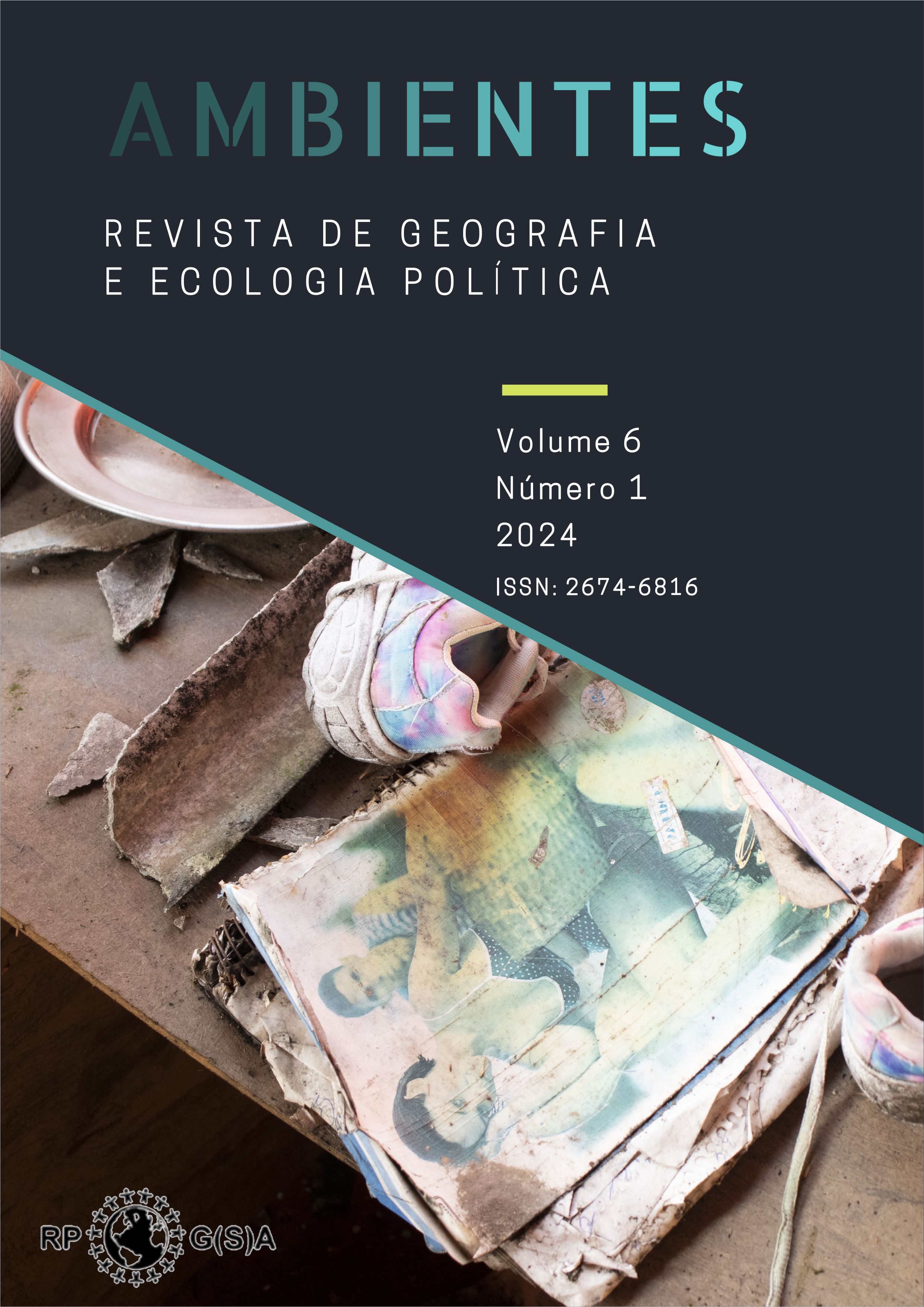(Ir)responsabilidade Social Corporativa: Mulheres atingidas pela Ternium em Santa Cruz, Rio de Janeiro
Corporate Social (Ir)responsibility: Women affected by Ternium steel mill in Santa Cruz, Rio de Janeiro
DOI :
https://doi.org/10.48075/amb.v6i1.33135Résumé
A siderúrgica Ternium (antiga TKCSA), localizada no bairro de Santa Cruz, Zona Oeste do Rio de Janeiro, é responsável por diversos impactos ambientais, como a contaminação crônica do ar, episódios agudos de contaminação (chuvas de prata) e inundações em áreas residenciais adjacentes. No entanto, entendemos que as mulheres são especialmente vulnerabilizadas com a chegada do empreendimento e, por isso, realizamos uma leitura dos impactos e estratégias da fábrica a partir de um recorte de gênero. A siderúrgica promove, desde o início de suas operações, diversas ações sociais em benefício dos moradores dos seus arredores, entendidas como práticas espaciais estratégicas da empresa. O presente artigo tem como objetivo fazer um levantamento das ações promovidas atualmente e examinar sua distribuição espacial. Além disso, iremos analisar as tramas enunciativas expressas no site com relação à representatividade feminina e às ações sociais da Ternium à luz dos impactos que a empresa causa nos corpos feminizados. Concluímos que a empresa utiliza uma gramática feminista como estratégia de branding, buscando apagar as violências geradas pelas práticas produtivas da empresa em diferentes escalas: do bairro à casa e aos corpos feminizados. Tais estratégias são insuficientes para compensar aos grupos atingidos pelas (ir)responsabilidade social corporativa que a fábrica construiu ao longo de todas suas fases administrativas.
Palavras-chave: Mulheres atingidas; Responsabilidade Social Corporativa; Zona de Sacrifício; Environmental Social Governance; Ternium.
Corporate Social (Ir)responsibility: Women affected by Ternium steel mill in Santa Cruz, Rio de Janeiro
Abstract
The Ternium steel mill (former TKCSA), located in the neighborhood of Santa Cruz, West Zone of Rio de Janeiro, is responsible for several environmental impacts, such as chronic air contamination, acute episodes of contamination (silver rains) and flooding in adjacent residential areas. However, we understand that women are especially vulnerable with the arrival of the enterprise and, therefore, we read the impacts and strategies of the factory from a gender perspective. Since the beginning of its operations, the steel company has promoted several social actions for the benefit of the residents of its surroundings, understood as strategic spatial practices of the company. The aim of this article is to survey the actions currently promoted and to examine their spatial distribution. In addition, we will analyze the enunciative plots expressed on the website in relation to female representation and Ternium's social actions in light of the impacts that the company causes on feminized bodies. We conclude that the company uses a feminist grammar as a branding strategy, seeking to erase the violence generated by the company's production practices at different scales: from the neighborhood to the home and feminized bodies. Such strategies are insufficient to compensate the groups affected by the corporate social (ir)responsibility that the factory has built throughout all its administrative phases.
Keywords: Women affected; Corporate Social Responsibility; Sacrifice Zone; Environmental Social Governance; Ternium.
(Ir)responsabilidad Social Corporativa: Mujeres afectadas por Ternium en Santa Cruz, Río de Janeiro
Resumen
La acería Ternium (antes TKCSA), ubicada en el barrio de Santa Cruz, Zona Oeste de Río de Janeiro, es responsable de varios impactos ambientales, como contaminación crónica del aire, episodios agudos de contaminación (lluvias de plata) e inundaciones en áreas residenciales adyacentes. Sin embargo, entendemos que las mujeres son especialmente vulnerables con la llegada de la empresa y, por ello, leemos los impactos y estrategias de la fábrica desde una perspectiva de género. Desde el inicio de sus operaciones, la empresa siderúrgica ha promovido diversas acciones sociales en beneficio de los vecinos de su entorno, entendidas como prácticas espaciales estratégicas de la empresa. El objetivo de este artículo es estudiar las acciones que se promueven actualmente y examinar su distribución espacial. Además, analizaremos las tramas enunciativas expresadas en el sitio web en relación con la representación femenina y las acciones sociales de Ternium a la luz de los impactos que la empresa provoca en los cuerpos feminizados. Se concluye que la empresa utiliza una gramática feminista como estrategia de branding, buscando borrar la violencia generada por las prácticas de producción de la empresa a diferentes escalas: desde el barrio hasta el hogar y los cuerpos feminizados. Tales estrategias son insuficientes para compensar a los grupos afectados por la (ir)responsabilidad social corporativa que la fábrica ha construido a lo largo de todas sus fases administrativas.
Palabras clave: Mujeres afectadas; Responsabilidad Social Empresarial; Zona de Sacrificio; Gobierno Social Ambiental; Ternium.
Téléchargements
Publié-e
Comment citer
Numéro
Rubrique
Licence

Cette œuvre est sous licence Creative Commons Attribution - Pas d'Utilisation Commerciale - Partage dans les Mêmes Conditions 4.0 International.
Aviso de Direito Autoral Creative Commons
Política para Periódicos de Acesso Livre
Autores que publicam nesta revista concordam com os seguintes termos:
1. Autores mantém os direitos autorais e concedem à revista o direito de primeira publicação, com o trabalho simultaneamente licenciado sob a Licença Creative Commons Attribution que permite o compartilhamento do trabalho com reconhecimento da autoria e publicação inicial nesta revista.2. Autores têm autorização para assumir contratos adicionais separadamente, para distribuição não-exclusiva da versão do trabalho publicada nesta revista (ex.: publicar em repositório institucional ou como capítulo de livro), com reconhecimento de autoria e publicação inicial nesta revista.
3. Autores têm permissão e são estimulados a publicar e distribuir seu trabalho online (ex.: em repositórios institucionais ou na sua página pessoal) a qualquer ponto antes ou durante o processo editorial, já que isso pode gerar alterações produtivas, bem como aumentar o impacto e a citação do trabalho publicado (Veja O Efeito do Acesso Livre).
Licença Creative Commons
Esta obra está licenciada com uma Licença Creative Commons Atribuição-NãoComercial-CompartilhaIgual 4.0 Internacional, o que permite compartilhar, copiar, distribuir, exibir, reproduzir, a totalidade ou partes desde que não tenha objetivo comercial e sejam citados os autores e a fonte.


